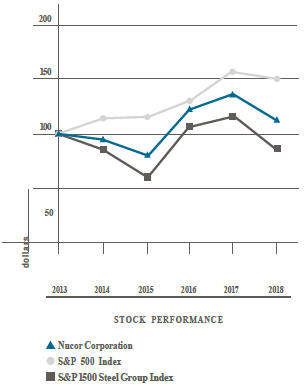Management’s Discussion and Analysis of Financial Condition and Results of Operations
Overview
The strong U.S. economy drove steel demand higher in 2018, helping fuel Nucor’s record earnings. The U.S. economy grew about 3%, compared to 2.3% in 2017 and 1.5% in 2016. This year we saw solid demand for steel in nearly every market we serve. The average utilization rates of all operating facilities in our steel mills, steel products and raw materials segments were approximately 91%, 71% and 72%, respectively, in 2018, compared with 86%, 65% and 65%, respectively, in 2017. All of our product groups in the steel mills segment realized improved utilization rates in 2018 over the prior year. Industry-wide, the U.S. capacity utilization rate was 78.3% for 2018, its highest annual rate since 2008.
The Section 232 steel tariffs provided us a tailwind in 2018 to the strong economy. For the full year 2018, steel imports were down more than 10% from the previous year and accounted for approximately 23% of U.S. market share. About 4.1 million fewer tons of imports entered the United States in 2018. Ninety percent of the decrease in imports, took place after the tariffs were fully implemented on June 1, 2018. The strong economy and lower imports generated 5 to 6 million tons in increased production for the U.S. steel industry this year.
We expect 2019 to be another good year for the U.S. steel industry. Most of the economic indicators we track continue to look favorable. While the economy may not grow at the same pace in 2019, we believe it will be strong compared to recent history. As we enter 2019, of the 24 end markets Nucor serves, we believe that 20 are improving, three are steady, and one is declining.
Our Challenges and Risks
Sales of many of our products are largely dependent upon capital spending in the nonresidential construction markets in the United States, including in the industrial and commercial sectors, as well as capital spending on infrastructure that is publicly funded, such as bridges, schools, prisons and hospitals. We are encouraged by the Trump administration’s recent commentary on initiatives that should spur greater economic growth, including increased infrastructure spending, the rolling back of excessive regulations and the encouragement of domestic energy production.
While the Section 232 tariffs are having their intended impact by keeping unfairly traded imports out of the U.S. market, global steel production overcapacity continues to be a long-term challenge. Steel production in China rose in 2018, going from 960 million tons in 2017 to 1.02 billion tons in 2018 – an increase of 6.6%. China’s share of global crude steel production rose from 50.3% in 2017 to 51.3% in 2018. The Organisation for EconomicCo-operation and Development estimates that global excess steel production capacity was approximately 600 million tons at the end of 2017, a drop from its peak levels in 2015 and 2016. Nearly half of that excess capacity is located in China, where the largest steel companies are state-owned and receive significant financial support from the Chinese government.
The Trump administration reached agreements with Argentina, Brazil and South Korea to exempt those countries from the steel tariffs in exchange for quotas on the amount of steel they export to the United States. Discussions with other trading partners, including the E.U., Canada, Mexico and Japan, could result in similar exemptions from the tariffs in exchange for quotas. The Trump administration is also negotiating with China after the United States imposed tariffs on a broad array of Chinese products. One of the goals of the Trump administration in those talks is getting China to agree to structural reforms in its economy, including the role of state-owned enterprises. Failure to address the overcapacity problem in the steel industry could adversely impact U.S. steelmakers by encouraging dumping steel products in our market, particularly if the Section 232 tariffs are lifted in the future.
The United States also reached a new trade agreement with Canada and Mexico. Several new provisions in the U.S.-Mexico-Canada Agreement (the “USMCA”), including increasing the rules of origin requirements for various products, should result in the use of more North American steel and other materials. Increasing these requirements, particularly for automotive production, will benefit North American steelmakers. However, the USMCA cannot take effect until it is passed by both houses in Congress. At this time, prospects for passage in 2019 are uncertain.
A major uncertainty we continue to face in our business is the price of our principal raw material, ferrous scrap, which is volatile and often increases or decreases rapidly in response to changes in domestic demand, unanticipated events that affect the flow of scrap into scrap yards, the availability of scrap substitutes and changes in foreign demand for scrap. In periods of rapidly increasing raw material prices in the industry, which are often also associated with periods of strong or rapidly improving steel market conditions, being able to increase our prices for the products we sell quickly enough to offset increases in the prices we pay for ferrous scrap is challenging but critical to maintaining our profitability. We attempt to mitigate the scrap price risk by managing scrap inventory levels at the steel mills to match the anticipated demand over the next several weeks. Certain scrap substitutes, including pig iron, have longer lead times for
24

